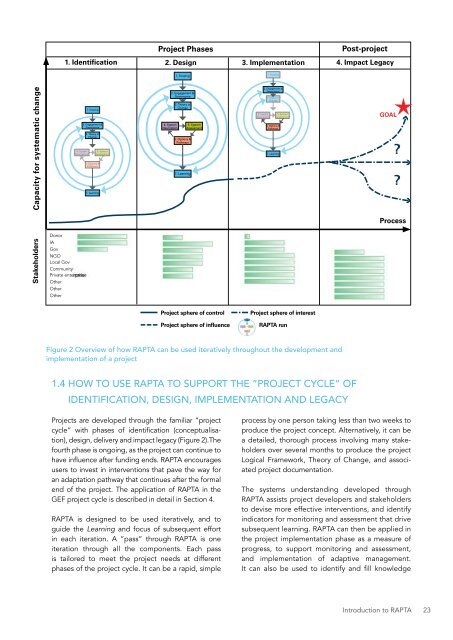DESIGNING PROJECTS IN A RAPIDLY CHANGING WORLD
srun3013fp1
srun3013fp1
Create successful ePaper yourself
Turn your PDF publications into a flip-book with our unique Google optimized e-Paper software.
Project Phases<br />
Post-project<br />
1. Identification 2. Design 3. Implementation 4. Impact Legacy<br />
1. Scoping<br />
1. Scoping<br />
Stakeholders Capacity for systematic change<br />
4. System<br />
Description<br />
Donor<br />
IA<br />
Gov<br />
NGO<br />
Local Gov<br />
Community<br />
Private enterprise<br />
Other<br />
Other<br />
Other<br />
1. Scoping<br />
2. Engagement &<br />
Governance<br />
3. Theory of<br />
Change<br />
6. Options &<br />
Pathways<br />
7. Learning<br />
5. System<br />
Assessment<br />
2. Engagement &<br />
Governance<br />
3. Theory of<br />
Change<br />
4. System 5. System<br />
Description Assessment<br />
6. Options &<br />
Pathways<br />
7. Learning<br />
2. Engagement &<br />
Governance<br />
3. Theory of<br />
Change<br />
4. System 5. System<br />
Description Assessment<br />
6. Options &<br />
Pathways<br />
7. Learning<br />
GOAL<br />
?<br />
?<br />
Process<br />
Project sphere of control<br />
Project sphere of interest<br />
Project sphere of influence<br />
RAPTA run<br />
Figure 2 Overview of how RAPTA can be used iteratively throughout the development and<br />
implementation of a project<br />
1.4 HOW TO USE RAPTA TO SUPPORT THE “PROJECT CYCLE” OF<br />
IDENTIFICATION, DESIGN, IMPLEMENTATION AND LEGACY<br />
Projects are developed through the familiar “project<br />
cycle” with phases of identification (conceptualisation),<br />
design, delivery and impact legacy (Figure 2).The<br />
fourth phase is ongoing, as the project can continue to<br />
have influence after funding ends. RAPTA encourages<br />
users to invest in interventions that pave the way for<br />
an adaptation pathway that continues after the formal<br />
end of the project. The application of RAPTA in the<br />
GEF project cycle is described in detail in Section 4.<br />
RAPTA is designed to be used iteratively, and to<br />
guide the Learning and focus of subsequent effort<br />
in each iteration. A “pass” through RAPTA is one<br />
iteration through all the components. Each pass<br />
is tailored to meet the project needs at different<br />
phases of the project cycle. It can be a rapid, simple<br />
process by one person taking less than two weeks to<br />
produce the project concept. Alternatively, it can be<br />
a detailed, thorough process involving many stakeholders<br />
over several months to produce the project<br />
Logical Framework, Theory of Change, and associated<br />
project documentation.<br />
The systems understanding developed through<br />
RAPTA assists project developers and stakeholders<br />
to devise more effective interventions, and identify<br />
indicators for monitoring and assessment that drive<br />
subsequent learning. RAPTA can then be applied in<br />
the project implementation phase as a measure of<br />
progress, to support monitoring and assessment,<br />
and implementation of adaptive management.<br />
It can also be used to identify and fill knowledge<br />
Introduction to RAPTA 23


